In this issue:
Linda Kohanov teams up with equine artist Kim McElroy in a rare workshop offering
Revisiting A Tribute to Tabula Rasa
Kohanov and McElroy join forces in Horse as Muse November 19 to 22
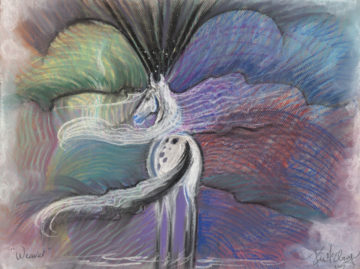
“Each of us has a creative spirit within us that yearns to express itself. Somewhere along the way that spirit may have been reined in. Horses can inspire you to set your creative spirit free. Then the interwoven patterns you glimpse in your life and your dreams can be expressed and explored in a tangible way.”
— Kim McElroy
“It is an act of revolution—and evolution—to reclaim
your creativity from the Cult of Experts, all those stodgy authority figures who strive to convince people that only professional artists, musicians, dancers, and writers are allowed to explore and express their deepest, most elusive feelings and insights. In the process, those same authority figures condition us to act as machines. Over time, we lose the vitality and imagination that is the birthright of every human being, and we’re much more likely to become work horses for others’ mundane ambitions.”
— Linda Kohanov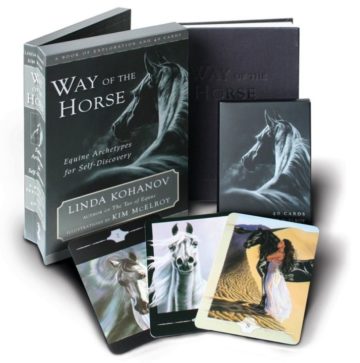
In 2007, bestselling author Linda Kohanov and acclaimed equine artist Kim McElroy combined forces to create Way of the Horse: Equine Archetypes for Self Discovery. This deck of stunning images and the accompanying book of essays has since been translated into Dutch, French and German. That same year, Kim and Linda led the very first Horse as Muse workshop in Arizona. Participants loved the potent combination of creativity-boosting experiences that included horse-facilitated exercises, journeying and guided visualizations, myth-making, storytelling, music-making, and meditations with the horses—all the while learning how to paint with pastels through Kim’s unique approach to expressing feelings and images that can never be put into words.
Plans were made for future Horse as Muse workshops, but busy schedules have kept Kim and Linda apart far too long. Now, nearly a decade later, the two will host another Horse as Muse workshop with the Eponaquest herd in Amado, Arizona, November 19 to 22, 2016. To register: http://eponaquest.com/workshop/horse-as-muse/.
“We think drawing comes from our outer sight—our eyesight. But it is actually insight—it is our mind’s eye that is activated through inspiration and transformation,” Kim emphasizes. “But experiences that lead us to self awareness are elusive at best and difficult to describe. When one learns to access art as a way of putting feelings and experiences onto paper, a new kind of dialogue with the self can begin to unfold. In the Horse as Muse, we learn to use art as a form of communication that is less about words, which tend to focus and condense, and more about pictures, which tend to express and expand.”
“Humans beings have an incredible capacity for imagining and then manifesting new visions that benefit others, sometimes at a global level,” Linda adds. “But on a daily basis, exercising our creative and intuitive gifts gives us immense personal fulfillment, enlivening the soul, helping us to integrate reason and feeling, embrace both logical and mythological/symbolic insights, and connect much more deeply with nature and spirit, self and other. In this respect, horses act as agents of inspiration and expanded awareness, a reputation they have long held in cultures around the world.”

Pegasus, the winged horse of the ancient Greeks, is just one example of many cross-cultural myths that emphasize the ability of the horse to jump start imagination and intuition in humans. Most people know that Pegasus was the companion to the muses and a messenger of the gods, which symbolically points to the horse’s ability to enhance creativity and non-logical sources of insight and expanded awareness. Yet a lesser-known aspect of this Greek myth is even more revealing. Early in his “career,” Pegasus flew up to Mount Helicon, the mountain of the muses, and stomped his hoof firmly on the ground, creating a massive earthquake. In this act, Pegasus opened a chasm in parched earth and solid stone, releasing a hidden spring that gushed forth and cascaded down the mountain, creating an oasis of new growth. Forever thereafter, as the story goes, the river known as the Hippocrene (literally ‘horse spring’) flowed with inspiration. Artists, writers, composers, and inventors would hike into the wilderness to sit on its banks, drink its energizing waters, and listen to its gentle music, always returning with a new song, poem, painting, or vision of change and renewal.
“Over the last 20 years, I’ve seen quite clearly that the myth of Pegasus lives on in our flesh and blood horses,” says Linda Kohanov. “When people are supported in spending time with these powerful yet gentle animals outside conventional training and showing contexts, horses reliably enact the Pegasus myth, opening deep chasms in our hearts, blasting through limiting habits of thought and behavior that have solidified through social conditioning. At that moment, we suddenly have access to flowing sources of inspiration, intuition, and renewal.”
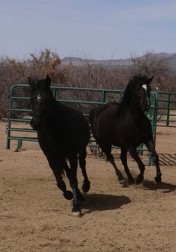
With the help of the Eponaquest herd, Linda and Kim will not only lead participants through a variety of heart and mind-opening experiences, they will share techniques for capturing and sharing these insights through visual art, poetry, myth and other forms of creative writing.
This workshop is limited to eight people. No horse or art experience necessary. Professional grade art supplies and writing materials will be provided.
A Tribute to Tabula Rasa
This month marks the fifth anniversary of the powerful transition of Linda Kohanov’s very first muse, Tabula Rasa. The black Arabian mare left this world on May 9, 2011.
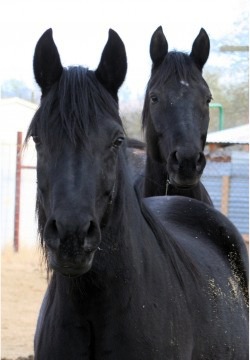
“As the primary inspiration for my books The Tao of Equus and Riding between the Worlds, Rasa has touched hundreds of thousands of lives around the world,” Linda says. “While I still miss her very much, I’m lucky to have her family living and working with me, with each member of the black horse herd carrying Rasa’s legacy forward in their own inimitable ways.
“Rasa’s sons Spirit and Indigo Moon (sired by Midnight Merlin), and their statuesque half brother Orion (son of Merlin and Comet) have become skilled teachers. Rasa’s beautiful granddaughter Artemis (daughter of Spirit and Panther) is particularly gifted in working with people, as is her empowered yet still gentle mother Panther.”
As was her nature, Rasa drew many people, horses, symbols and synchronicities together that still bring new insights to light. Even her final days were profound.
An excerpt from A Tribute to Tabula Rasa
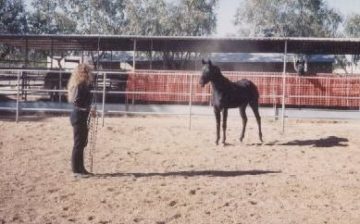
Sitting quietly with Rasa, breathing in sync with her mindful acceptance of each and every moment, entraining with the beat of her massive heart, I always felt a deep, renewing peace engulf me, no matter what trials I might otherwise be enduring. This in itself was a daily miracle. Her presence, however, was powerful, not passive. Horses, she taught me early on, actively mirror the nuances of how people show up each day, highlighting our hidden gifts, our wounds, our vulnerabilities, and our worn-out worldly habits. And yet somehow they manage to be discerning without a hint of judgment, communicating that at the core, we too are beautiful, powerful, and wise, capable of endless renewal.
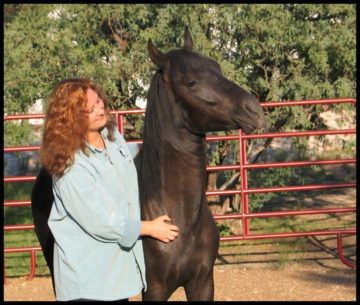
In the eyes of my horse Tabula Rasa, I came to see human dysfunctions as surface scintillations, dramatic and sometimes irritating to be sure, but certainly not set in stone. Whenever I managed, through grace or sheer stubborn will, to let go of an old pattern and embody a fresh perspective, Rasa would mirror the transformation, welcoming me home to an ever deeper understanding of who I really was. And without the slightest hint of ambition, she would continually up the ante, stretching, relentlessly, my own limited ideas about my place in the world, my calling, my untapped potential, and even, as it turns out, the nature of reality itself. Because the ultimate contradiction, the ultimate paradox Tabula Rasa brought to light involved embracing logic and mystery simultaneously, treating them as equal partners, as twin forms of consciousness. She even went to the trouble of having twin sons in 2002 to underline that point. Her first-born son, Spirit, against all odds, stayed in this world to eventually sire his own daughter Artemis. His identical twin brother, Sanctus, was stillborn. In one outlandish gesture, Rasa gave birth to life and death simultaneously, vividly and forever connecting us to this world and the other. Sometimes late at night, I still catch a glimpse of Spirit’s brother shadowing him, dancing in the moonlight. 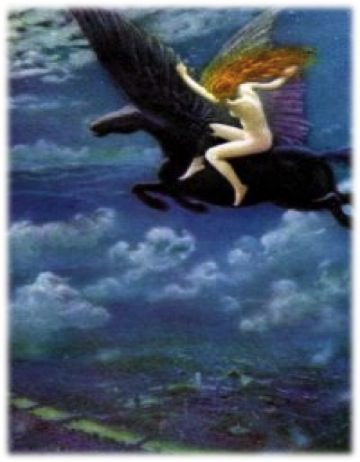
Rasa’s lesson plan for me, and for thousands of people around the world who became her students in one way or another, involved a wildly expanded, inter-disciplinary approach to life. She insisted that we become more effective in navigating the challenges of a concrete, earthly reality, while also exercising our innate yet long-suppressed ability to collaborate with an ephemeral, eternally morphing spiritual reality, to claim our birthright as co-creators in a universe capable of dreaming big dreams. In this effort, Rasa taught us to not just appreciate mystery but to ride it, to use the challenges, frustrations, disappointments and pain of life to exercise a warrior’s courage, not to conquer the known world, but to reach into the fertile darkness of the magnificent void and speak what has never been spoken, write what has never been written, paint what has never been seen, dream what has never been dreamed.
To read the entire Tribute to Tabula Rasa, with more photos, artwork and music, http://eponaquest.com/a-tribute-to-tabula-rasa/.